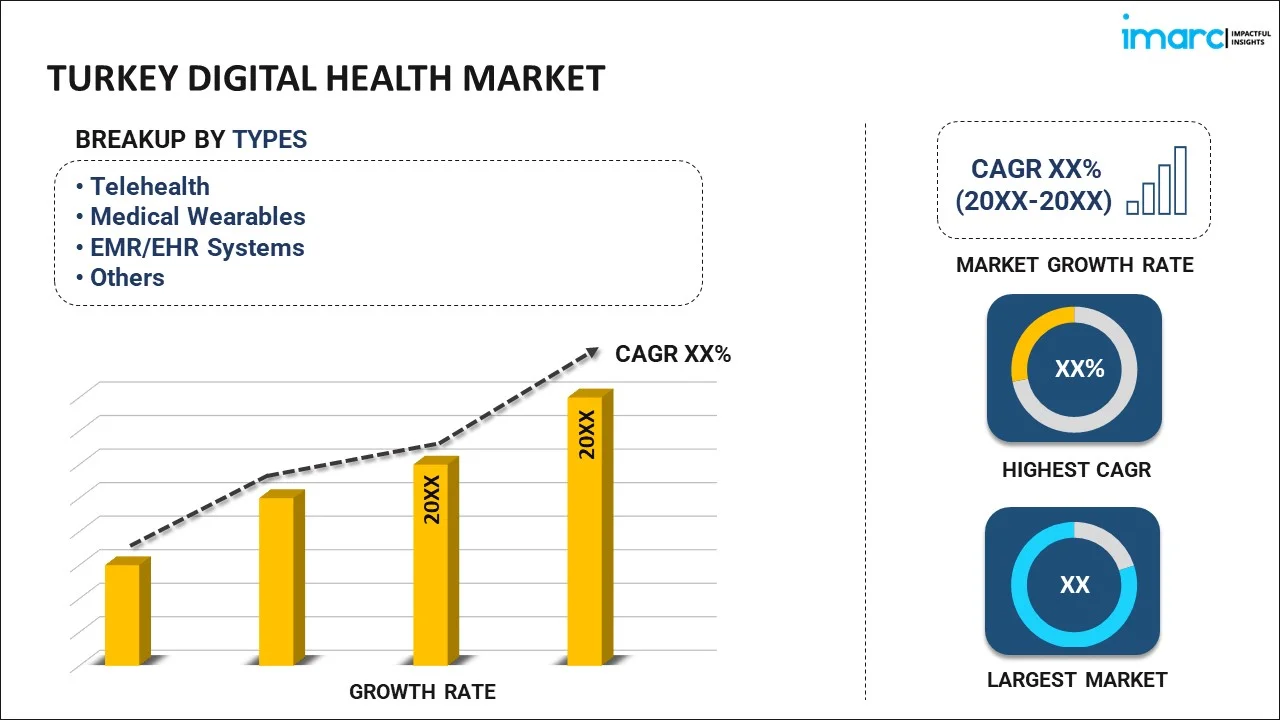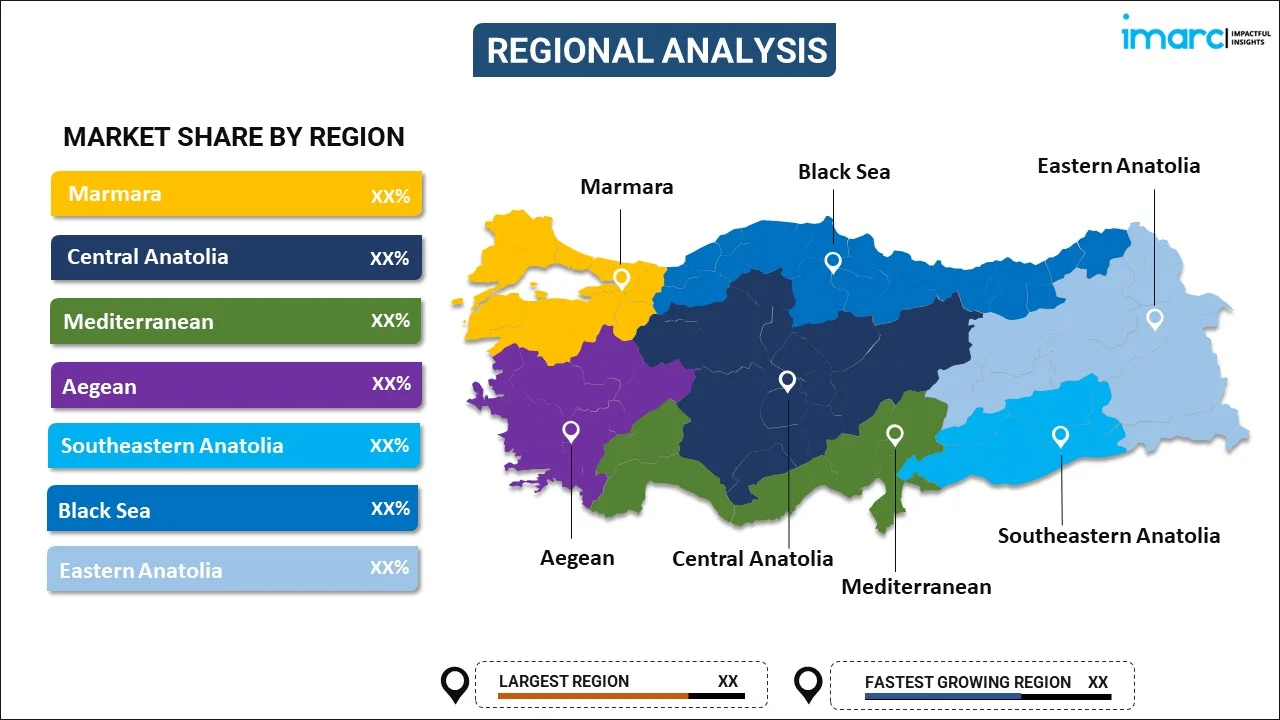
Turkey Digital Health Market Report by Type (Telehealth, Medical Wearables, EMR/EHR Systems, Medical Apps, Healthcare Analytics, and Others), Component (Software, Hardware, Service), and Region 2025-2033
Turkey Digital Health Market Overview:
The Turkey digital health market is projected to exhibit a growth rate (CAGR) of 13.50% during 2025-2033. Increasing telemedicine adoption, supportive government initiatives, and rising healthcare expenditure, expanding internet access and smartphone usage, COVID-19 accelerated digital health adoption, regulatory support and industry collaborations are some of the factors stimulating the market growth.
|
Report Attribute
|
Key Statistics
|
|---|---|
|
Base Year
|
2024 |
|
Forecast Years
|
2025-2033
|
|
Historical Years
|
2019-2024
|
| Market Growth Rate (2025-2033) | 13.50% |
Turkey Digital Health Market Trends:
Increasing Adoption of Telemedicine and Remote Patient Monitoring
Turkey's digital healthcare market is driven largely by the growing use of telemedicine and remote patient monitoring solutions. This trend further supported by the need to provide accessible healthcare across the country, specifically as found in rural areas. In line with this, telemedicine enables doctors to consult with patients at a distance, which is most useful as it allows the patients that are located in remote areas from clinics and specialist care services to receive that help in their own homes. Another significant driver for the market is the escalating popularity of continuous health tracking, which helps in the management of chronic diseases and reduce hospital admissions. Furthermore, the advent of telecommunications infrastructure and rapid development in mobile technology make it possible for real-time communication and data exchange between patients and medical professionals, which is creating a positive outlook for the market growth. Apart from this, the COVID-19 pandemic has accelerated the adoption of digital health solutions, thus underscoring its role in maintaining continuity of care during such crises and easing strain on physical healthcare facilities.
Government Initiatives and the National Health Information System (NHIS)
The government of Turkey has implemented the National Health Information System (NHIS) to integrate health information across both the public and private health-care sectors and promote interoperability and data exchange among health-care providers. This initiative aims to improve administrative efficiency, evidence-based decision-making and drive improvements in general healthcare policy. In line with this, the ability to digitize health records and standardize data collection across the health infrastructure is providing a thrust to the market growth. Furthermore, government support encourages investments in healthcare information technology (IT) infrastructure and helps foster collaboration between technology providers and healthcare institutions, which is stimulating the market growth.
Rising Healthcare Expenditure and Growing Elderly Population
Turkey's increasing healthcare expenditure and growing geriatric population are significant drivers of the digital health market. As healthcare costs rise and the population ages, there is a growing demand for efficient healthcare delivery models and technologies that improve patient outcomes while optimizing resource utilization. Digital health solutions, such as telehealth platforms and remote monitoring devices, address these challenges by enabling proactive management of chronic conditions and reducing the need for costly hospital visits. Moreover, the elderly population, who often require ongoing medical care and monitoring, benefit from technologies that support aging in place and enhance caregiver coordination.
Turkey Digital Health Market News:
- In 2024, HIMSS Analytics announced the launch of a modernized Infrastructure Adoption Model (INFRAM). This updated model emphasizes five key domains: cybersecurity, sustainability, performance, adoption, and outcomes. It aims to help healthcare leaders analyze and optimize their health system’s technical infrastructure, reducing costs, mitigating risks, and improving outcomes. The INFRAM provides a comprehensive assessment report that identifies critical gaps and investment opportunities, offering a roadmap for future improvements.
- In 2024, Acıbadem Hospitals, a leading healthcare provider based in Turkey with a broad international reach, has launched its Online Second Medical Opinion service. This initiative allows patients to seek a review of their medical diagnoses remotely, providing them with the opportunity to verify or challenge their initial medical assessments from the comfort of their homes.
Turkey Digital Health Market Segmentation:
IMARC Group provides an analysis of the key trends in each segment of the market, along with forecasts at the country level for 2025-2033. Our report has categorized the market based on type and component.
Type Insights:

- Telehealth
- Medical Wearables
- EMR/EHR Systems
- Medical Apps
- Healthcare Analytics
- Others
The report has provided a detailed breakup and analysis of the market based on the type. This includes telehealth, medical wearables, EMR/EHR systems, medical apps, healthcare analytics, and others.
Component Insights:
- Software
- Hardware
- Service
A detailed breakup and analysis of the market based on the component have also been provided in the report. This includes software, hardware, and service.
Regional Insights:

- Marmara
- Central Anatolia
- Mediterranean
- Aegean
- Southeastern Anatolia
- Blacksea
- Eastern Anatolia
The report has also provided a comprehensive analysis of all the major regional markets, which include Marmara, Central Anatolia, Mediterranean, Aegean, Southeastern Anatolia, Blacksea, and Eastern Anatolia.
Competitive Landscape:
The market research report has also provided a comprehensive analysis of the competitive landscape in the market. Competitive analysis such as market structure, key player positioning, top winning strategies, competitive dashboard, and company evaluation quadrant has been covered in the report. Also, detailed profiles of all major companies have been provided.
Turkey Digital Health Market Report Coverage:
| Report Features | Details |
|---|---|
| Base Year of the Analysis | 2024 |
| Historical Period | 2019-2024 |
| Forecast Period | 2025-2033 |
| Units | Billion US$ |
| Scope of the Report | Exploration of Historical and Forecast Trends, Industry Catalysts and Challenges, Segment-Wise Historical and Predictive Market Assessment:
|
| Types Covered | Telehealth, Medical Wearables, EMR/EHR Systems, Medical Apps, Healthcare Analytics, Others |
| Components Covered | Software, Hardware, Service |
| Regions Covered | Marmara, Central Anatolia, Mediterranean, Aegean, Southeastern Anatolia, Blacksea, Eastern Anatolia |
| Customization Scope | 10% Free Customization |
| Post-Sale Analyst Support | 10-12 Weeks |
| Delivery Format | PDF and Excel through Email (We can also provide the editable version of the report in PPT/Word format on special request) |
Key Questions Answered in This Report:
- How has the Turkey digital health market performed so far and how will it perform in the coming years?
- What has been the impact of COVID-19 on the Turkey digital health market?
- What is the breakup of the Turkey digital health market on the basis of type?
- What is the breakup of the Turkey digital health market on the basis of component?
- What are the various stages in the value chain of the Turkey digital health market?
- What are the key driving factors and challenges in the Turkey digital health?
- What is the structure of the Turkey digital health market and who are the key players?
- What is the degree of competition in the Turkey digital health market?
Key Benefits for Stakeholders:
- IMARC’s industry report offers a comprehensive quantitative analysis of various market segments, historical and current market trends, market forecasts, and dynamics of the Turkey digital health market from 2019-2033.
- The research report provides the latest information on the market drivers, challenges, and opportunities in the Turkey digital health market.
- Porter's five forces analysis assist stakeholders in assessing the impact of new entrants, competitive rivalry, supplier power, buyer power, and the threat of substitution. It helps stakeholders to analyze the level of competition within the Turkey digital health industry and its attractiveness.
- Competitive landscape allows stakeholders to understand their competitive environment and provides an insight into the current positions of key players in the market.
Need more help?
- Speak to our experienced analysts for insights on the current market scenarios.
- Include additional segments and countries to customize the report as per your requirement.
- Gain an unparalleled competitive advantage in your domain by understanding how to utilize the report and positively impacting your operations and revenue.
- For further assistance, please connect with our analysts.
 Inquire Before Buying
Inquire Before Buying
 Speak to an Analyst
Speak to an Analyst
 Request Brochure
Request Brochure
 Request Customization
Request Customization




.webp)




.webp)












